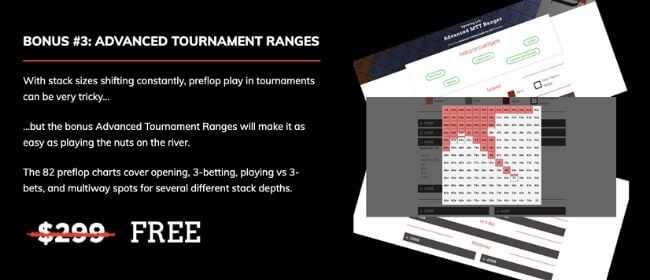Upswing Poker 3 Bet Ranges
The 3-bet (or more specifically, light 3-betting) is an advanced concept that adds an extra weapon to a game that has likely become repetitive and stagnant, even if that current game strategy is winning you money at the tables. So we expect villain to bet with this range: QQ+,55,22,AQs,KQs,Q9s+,AQo,KQo. That will be his ‘value’ hand range. A value range is the range of hands he will bet hoping that he is betting to build a big pot. He will also have some bluffs such as AK, KJs, JTs and possibly AJ. However, the number of bluffs is very dependent on how the. This includes hand ranges for opening, playing vs an opener in position, 3-bet and 4-bet pots plus advanced tournament ranges. You can save tens of hours of solver analysis by using these pre-calculated solutions. Sizes: 2.25bb RFI, 7.25bb 3-bet, 23.25 4-bet 3-bet to 9.75bb from SB, 11.25bb from BB Fried then took the outputted ranges and went over them thoroughly, simplifying the overall strategy and mixed frequencies to make the charts easier to use in practice (without sacrificing significant EV). Get These Ranges Now and Save $50. In this video I am constructing ranges when facing a 3 bet. So I raise first in, and I get 3 bet, so I am creating ranges to call, 4 bet for value and 4 bet bluff. Check it and and feel free to.
The Upswing Poker Lab is a poker training course taught by Doug Polk, Ryan Fee, and other top poker pros. The Lab is updated regularly with in-depth learning modules, theory videos, and a wealth of information to make you a better poker player.
By Dan Baker
Playing against passive opposition might be easier than you think. It’s very easy to realize equity against these players because of how rarely they bet, and that incentivizes you to use more aggressive strategies both preflop and post-flop.

In this article, we’ll discuss those aggressive strategies, and how to play against one move in particular that is characteristic of most live poker players — namely, limping.
Preflop adjustments versus limpers
When playing live, the most important aspect of our strategy is how we play against limpers. This is due to how often players limp in live games.
When a player limps, there is a very good chance that he a recreational player. However, that doesn’t mean you should iso-raise him with any two cards.
Iso-raising is when you raise preflop after a player limps. The goal of this play is to isolate the limper in a heads-up pot post-flop.
A professional boxer wouldn’t swing wildly against an average non-fighter. Instead, he would carefully outmaneuver and out-punch his opponent until he knocked him out. There’s no reason for the boxer to allow for unnecessary risk.
Likewise, you shouldn’t let down your guard despite being the better player. Your edge comes from knowing how to maneuver through the hand, and how to extract more value with good hands and lose less with bad ones.

Without any prior information, a limp doesn’t mean an opponent has a weak range. His limping range might very well be made of Q-Q or better and A-K for all you know. Or maybe it’s only suited connectors and small pocket pairs.

Whatever the case may be, you need to begin from a conservative position and pay attention to the hands he shows down and to how often he limps. Only then can you make big adjustments.
There are many factors that should impact your iso-raising strategy, such as how often your opponent limp-folds — that is, folds to a raise after limping. For example, if he limp-folds a decent amount, you can loosen your requirements for iso-raising since you have added fold equity preflop, which allows you to profit with a wider range of hands.
Here’s a list of seven factors and how they should impact your iso-raising strategy against an opponent who limps:
- As they limp-fold more, you should iso-raise wider and vice-versa
- As they limp-three-bet more, you should iso-raise tighter and vice versa.
- As their limping range gets wider, you should iso-raise wider and vice-versa.
- When you are in position, you should iso-raise wider than when you are out of position.
- The more players there are behind you, the tighter you should iso-raise and vice-versa.
- As the players behind get looser and more aggressive, you should iso-raise tighter and vice-versa.
- As the limper plays more aggressively post-flop, you should iso-raise tighter and vice-versa.
As you can see, there are a lot of variables that influence an iso-raising strategy. Unfortunately, there are no fixed ranges that I or anyone can give you to play in these spots. You really just have to adjust and re-adjust as you play and learn more about your opponents.
Here are a few “vs limp” ranges from the live poker section of the Upswing Lab to help you get started:
The red hands are easy: just raise with them every time. The light blue hands should be raised, limped, or folded depending on the factors above.
For example, let’s say you’re in middle position and a player limps from early position. You know the limper is a weak player who often limp-folds. Additionally, none of the players behind are particularly aggressive. So, you should play loose and iso-raise with all of the light blue hands (A-9 suited, A-5 suited, K-10 suited, Q-10 suited, J-9 suited, 9-8 suited, 8-7 suited, 7-6 suited, 6-6, 5-5).
When should you limp behind?
Limping behind (or over-limping) is rarely the correct move theoretically, but that doesn’t mean you should never do it. There are some hands that are not quite strong enough to iso-raise with but are too strong to just throw into the muck. These borderline hands are what you want to limp behind with.
Before I show you some specific hands, you need to know a couple of factors that should make you avoid limping like the plague:
- If you have one or more aggressive players behind, avoid over-limping. These players will iso-raise too often which renders your limp -EV (negative expected value).
- If you are not in late position or in the small blind, avoid over-limping. Limping in earlier positions is usually too risky because one of the many players behind can wake up with a strong hand and iso-raise.
Conclusion
Playing at passive tables can be a relaxing way of printing money with the correct strategy. Make sure you stay disciplined and humble enough and not start spewing chips away just because you are playing against weaker players.
Sign up for the Upswing Poker Lab today for step-by-step instructions and examples to master both the fundamental theories and situational exploits to greatly increase your skill and earnings.